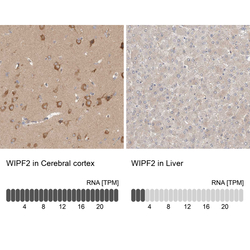Antibody data
- Antibody Data
- Antigen structure
- References [7]
- Comments [0]
- Validations
- Immunohistochemistry [1]
Submit
Validation data
Reference
Comment
Report error
- Product number
- HPA024467 - Provider product page

- Provider
- Atlas Antibodies
- Proper citation
- Atlas Antibodies Cat#HPA024467, RRID:AB_1858842
- Product name
- Anti-WIPF2
- Antibody type
- Polyclonal
- Description
- Polyclonal Antibody against Human WIPF2, Gene description: WAS/WASL interacting protein family, member 2, Alternative Gene Names: WICH, WIRE, Validated applications: WB, IHC, Uniprot ID: Q8TF74, Storage: Store at +4°C for short term storage. Long time storage is recommended at -20°C.
- Reactivity
- Human, Mouse, Rat
- Host
- Rabbit
- Conjugate
- Unconjugated
- Isotype
- IgG
- Vial size
- 100 µl
- Concentration
- 0.2 mg/ml
- Storage
- Store at +4°C for short term storage. Long time storage is recommended at -20°C.
- Handling
- The antibody solution should be gently mixed before use.
Submitted references miR-7b-3p Exerts a Dual Role After Spinal Cord Injury, by Supporting Plasticity and Neuroprotection at Cortical Level
Identification of a Subtype of Poorly Differentiated Invasive Ductal Carcinoma of the Breast Based on Vimentin and E-cadherin Expression
WIP and WICH/WIRE co-ordinately control invadopodium formation and maturation in human breast cancer cell invasion
A complex of ZO-1 and the BAR-domain protein TOCA-1 regulates actin assembly at the tight junction
Active contractility at E-cadherin junctions and its implications for cell extrusion in cancer
Cortical F-actin stabilization generates apical–lateral patterns of junctional contractility that integrate cells into epithelia
N-WASP regulates the epithelial junctional actin cytoskeleton through a non-canonical post-nucleation pathway
Ghibaudi M, Boido M, Green D, Signorino E, Berto G, Pourshayesteh S, Singh A, Di Cunto F, Dalmay T, Vercelli A
Frontiers in Molecular Biosciences 2021;8
Frontiers in Molecular Biosciences 2021;8
Identification of a Subtype of Poorly Differentiated Invasive Ductal Carcinoma of the Breast Based on Vimentin and E-cadherin Expression
Orlandini L, Reis F, da Silveira W, Tiezzi M, de Andrade J, Ribeiro-Silva A, Deaton R, Bosland M, Tiezzi D
Revista Brasileira de Ginecologia e Obstetrícia / RBGO Gynecology and Obstetrics 2018;40(12):779-786
Revista Brasileira de Ginecologia e Obstetrícia / RBGO Gynecology and Obstetrics 2018;40(12):779-786
WIP and WICH/WIRE co-ordinately control invadopodium formation and maturation in human breast cancer cell invasion
García E, Ragazzini C, Yu X, Cuesta-García E, Bernardino de la Serna J, Zech T, Sarrió D, Machesky L, Antón I
Scientific Reports 2016;6(1)
Scientific Reports 2016;6(1)
A complex of ZO-1 and the BAR-domain protein TOCA-1 regulates actin assembly at the tight junction
Van Itallie C, Tietgens A, Krystofiak E, Kachar B, Anderson J, Yap A
Molecular Biology of the Cell 2015;26(15):2769-2787
Molecular Biology of the Cell 2015;26(15):2769-2787
Active contractility at E-cadherin junctions and its implications for cell extrusion in cancer
Wu S, Lagendijk A, Hogan B, Gomez G, Yap A
Cell Cycle 2015;14(3):315-322
Cell Cycle 2015;14(3):315-322
Cortical F-actin stabilization generates apical–lateral patterns of junctional contractility that integrate cells into epithelia
Wu S, Gomez G, Michael M, Verma S, Cox H, Lefevre J, Parton R, Hamilton N, Neufeld Z, Yap A
Nature Cell Biology 2014;16(2):167-178
Nature Cell Biology 2014;16(2):167-178
N-WASP regulates the epithelial junctional actin cytoskeleton through a non-canonical post-nucleation pathway
Kovacs E, Verma S, Ali R, Ratheesh A, Hamilton N, Akhmanova A, Yap A
Nature Cell Biology 2011;13(8):934-943
Nature Cell Biology 2011;13(8):934-943
No comments: Submit comment
Supportive validation
- Submitted by
- Atlas Antibodies (provider)
- Enhanced method
- Orthogonal validation
- Main image

- Experimental details
- Immunohistochemistry analysis in human cerebral cortex and liver tissues using HPA024467 antibody. Corresponding WIPF2 RNA-seq data are presented for the same tissues.
- Sample type
- Human
- Protocol
- Protocol
 Explore
Explore Validate
Validate Learn
Learn Western blot
Western blot Immunohistochemistry
Immunohistochemistry